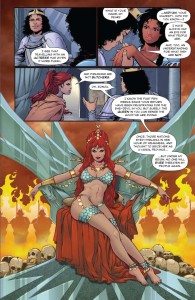Red Sonja Vol. 3, #2-6
Marguerite Bennett (writer), Aneke (illustrator), Aneke & Diego Galindo (illustrators #4-5), Jorge Sutil (colorist), Jorge Sutil & Morgan Hickman (colorists on #3), Erica Schultz (letterer)
Dynamite
2016
Disclaimer: This review is based on advanced review copies from Dynamite.
I had been anticipating Bennett’s work on Red Sonja ever since Dynamite made the official announcement that Bennett would take over from Simone. I reviewed the first issue with much fangurl squeeing, but Bennett is often one of those comic writers that I find easier to read in trade. Her work is often ambitious and dense with critique, and collected trades (or in this case collected advanced reviews) allow me to make connections among themes more readily. I actually moved to reading DC Bombshells in trade for the same reason. The wait often feels torturous, but it’s worth it.
Issue #6, which dropped June 15, completes the first arc in Bennett’s run on Red Sonja. I was an ardent devotee of Simone’s take on Red Sonja, and Bennett has artfully built on that representation while also biting off a huge chunk, in the typical ambitious Bennett fashion. While Simone focused on developing Sonja as a character and disrupting the lone wolf trope of the sword and sorcery genre, Bennett is aiming her pen at Hykrania itself. Sonja is still very much the stinky, queer hedonist of Simone’s pen, but she is also more pensive, even experiencing an existential crisis or two.
See, I have this unfleshed theory of the libertarianism in the sword and sorcery genre that, admittedly, some scholar of Ron Howard has almost certainly made. I can’t help it, though; I’m a scholar, and Bennett is a scholar’s writer. Logan Dalton, over at Popoptiq, does a great job of explaining how Bennett does this, so I won’t get into that here (so you should go read it!), but I will address two other important things going on in Bennett’s Red Sonja.
First of all, there’s women everywhere, and outside of the main antagonist, the men are merely accessories. In interviews, Bennett has made it clear that comics just need more female characters of all types, and she walks her talk in populating the first arc of Red Sonja with a myriad of female characters: Villainous women who serve the patriarchal oppression of beta males, cunning actresses who are more than sidekicks of Sonja, scholars and orators who lead rebellions, and those who turn over new leaves to right their past wrongs. Women are recruited into the evil King Savas’ army just as men are, and skin colors vary across the board.
Second, I appreciate how Bennett continues to build on the ways in which Simone dismantled the lone wolf trope that runs through the libertarian bent of the sword and sorcery genre. For example, in issue #5, when discussing the legend of Red Sonja, a play written by the actress Midyan explains how Sonja “bettered” those around her, but that they also “bettered her.” Whether intentional or not, it feels like women supporting women, acknowledging how we continually build on the work of our predecessors, and that no single person is responsible for it all.
 Similarly, I was continually delighted by Aneke’s expressive and curvaceous Sonja. Under Aneke’s hand, Sonja has the almond eyes, lush eyelashes, and thick lips of some of the most lasciviously drawn Red Sonjas that is undercut by a playfulness that calls back to Frank Thorne’s Red Sonja. I love it, and with the exception of some occasional strange contortions (and not in a creepy, objectifying way) from the characters, Aneke’s illustrations are pulpy fun suitable to the genre.
Similarly, I was continually delighted by Aneke’s expressive and curvaceous Sonja. Under Aneke’s hand, Sonja has the almond eyes, lush eyelashes, and thick lips of some of the most lasciviously drawn Red Sonjas that is undercut by a playfulness that calls back to Frank Thorne’s Red Sonja. I love it, and with the exception of some occasional strange contortions (and not in a creepy, objectifying way) from the characters, Aneke’s illustrations are pulpy fun suitable to the genre.
Sometimes, the coloring is garish to the point of being practically neon, and there’s an inexplicable amount of pink eyeshadow on the characters that comes off more campy than pulpy to me. I think the coloring could take a cue from Marguerite Sauvage, who illustrates and colors the main covers for the series. Sauvage’s covers have a surreal quality to them that, at first, I had trouble reconciling with the character of Red Sonja, but the soft color palette creates a dreamy tone that contrasts with the angry sneers on Sonja’s face.
Bennett and Aneke have certainly set a high standard for continuing the series. This Red Sonja is female-reader friendly while still maintaining the hedonism of barbarian comics and performing fascinating critiques of imperialism and sexism.

